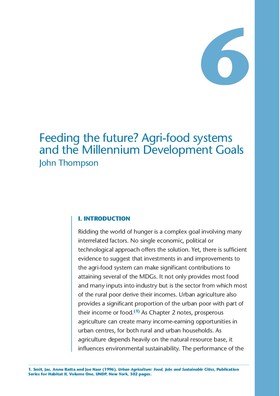93 6 Feeding the future? Agri-food systems and the Millennium Development Goals
Document begins: 93 6 Feeding the future? Agri-food systems and the Millennium Development Goals John Thompson I. INTRODUCTION Ridding the world of hunger is a complex goal involving many interrelated factors. No single economic, political or technological approach offers the solution. Yet, there is sufficient evidence to suggest that investments in and improvements to the agri-food system can make significant contributions to attaining several of the MDGs. It not only provides most food and many inputs into industry but is the sector from which most of the rural poor derive their incomes. Urban agriculture also provides a significant proportion of the urban poor with part of their income or food.(1) As Chapter 2 notes, prosperous agriculture can create many income-earning opportunities in urban centres, for both rural and urban households. As agriculture depends heavily on the natural resource base, it influences environmental sustainability. The performance of the 1. Smit, Jac, Annu Ratta and Joe Nasr (1996), Urban Agriculture: Food, Jobs and Sustainable Cities, Publication Series for Habitat II, Volume One, UNDP, New York, 302 pages. 94 sector is also closely linked to human health, both through its contribution to food supplies and to livelihoods. II. REDUCING RURAL POVERTY AND FOOD ...
Cite this publication
Available at https://www.iied.org/g00450
